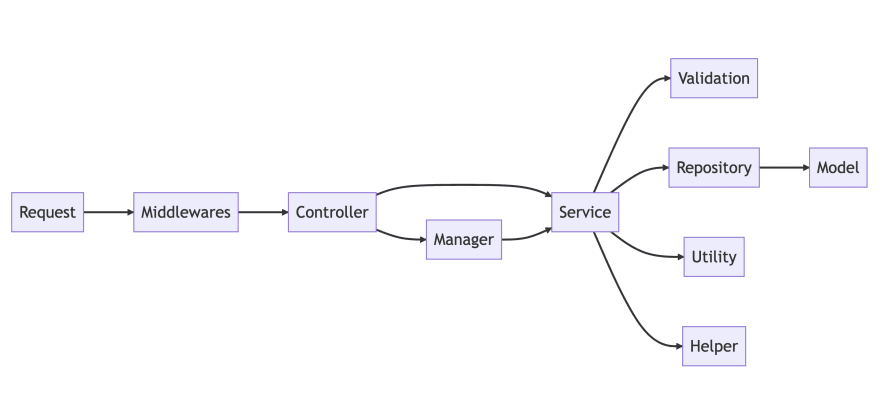Testing is a crucial aspect of software development, especially for web applications. In Go, testing is built into the language and provides powerful tools for writing and running tests.
In this article we will explore the flow of a Go web application, how to write unit tests for each layer of the application.
**The Flow of a Go Web Application
**When developing a Go web application, it’s important to understand the flow of data and control through each layer of the application. A typical flow might look like this:
In this diagram, a request starts in the browser and goes through a middleware layer, which then passes it to a controller. The controller interacts with a manager, which interacts with a service layer. The service layer in turn interacts with a validation layer for input and business rule validation, as well as a repository for data persistence, and utility and helper modules for additional functionality. Finally, the repository interacts with a model.
*Writing Unit Tests *
To ensure the quality and correctness of each layer of the application, we should write both unit tests and integration tests. Unit tests should focus on testing individual units of code in isolation, such as functions or methods within a single module. Writing unit tests for each layer of the application can help us catch issues early in the development cycle and ensure that each unit of code is behaving correctly.
For example, to write unit tests for the service layer, we can create mock implementations of the validation layer, repository, utility, and helper modules, and then test each method of the service layer in isolation. We can use the mock implementations to control the input and output of each method, and ensure that the service layer behaves as expected.
To write unit tests, we can use a testing framework like Go’s built-in testing package or a third-party package like testify. These frameworks provide tools for creating mock implementations of dependencies, running tests, and generating coverage reports.
Example Time:
Let’s say we have a service layer that handles user authentication, and it has the following method:
type AuthService interface {
Authenticate(username string, password string) (bool, error)
}
type AuthServiceImpl struct {
validator ValidationService
repo UserRepository
}
func NewAuthServiceImpl(validator ValidationService, repo UserRepository) AuthService {
return &AuthServiceImpl{
validator: validator,
repo: repo,
}
}
func (s *AuthServiceImpl) Authenticate(username string, password string) (bool, error) {
if err := s.validator.ValidateUsername(username); err != nil {
return false, err
}
if err := s.validator.ValidatePassword(password); err != nil {
return false, err
}
return s.repo.Authenticate(username, password)
}
//Validation Service
type ValidationService interface {
ValidateUsername(username string) error
ValidatePassword(password string) error
}
type ValidationServiceImpl struct{}
func (svc *ValidationServiceImpl) ValidateUsername(username string) error {
// perform validation logic
return nil // return nil if validation succeeds, or an error if it fails
}
func (svc *ValidationServiceImpl) ValidatePassword(password string) error {
// perform validation logic
return nil // return nil if validation succeeds, or an error if it fails
}
type UserRepository interface {
Authenticate(username string, password string) (bool, error)
}
type UserRepositoryImpl struct{}
func (repo *UserRepositoryImpl) Authenticate(username string, password string) (bool, error) {
// perform authentication logic
return true, nil
}
To test t*his service layer*, we can create mock implementations of the ValidationService and UserRepository dependencies, like this using testity/mock library.
type MockValidationService struct {
mock.Mock
}
func (m *MockValidationService) ValidateUsername(username string) error {
args := m.Called(username)
return args.Error(0)
}
func (m *MockValidationService) ValidatePassword(password string) error {
args := m.Called(password)
return args.Error(0)
}
type MockUserRepository struct {
mock.Mock
}
func (m *MockUserRepository) Authenticate(username string, password string) (bool, error) {
args := m.Called(username, password)
return args.Bool(0), args.Error(1)
}
func TestAuthenticate(t *testing.T) {
username := "testuser"
password := "testpassword"
mockValidator := new(MockValidationService)
mockValidator.On("ValidateUsername", username).Return(nil)
mockValidator.On("ValidatePassword", password).Return(nil)
mockRepo := new(MockUserRepository)
mockRepo.On("Authenticate", username, password).Return(true, nil)
authService := NewAuthServiceImpl(mockValidator, mockRepo)
authenticated, err := authService.Authenticate(username, password)
if err != nil {
t.Errorf("Unexpected error: %v", err)
}
if !authenticated {
t.Error("Expected authentication to succeed, but it failed")
}
}
In this example, we import the mock package from the testify toolkit and create mock implementations of the ValidationService and UserRepository dependencies using the MockValidationService and MockUserRepository structs. We then use the On method to specify the expected behaviour of each method call, and pass the mock dependencies to the NewAuthServiceImpl method to create a new AuthService instance.
Finally, we call the Authenticate method with test data, and check that the result is as expected. The mock package takes care of generating the necessary mock implementations and verifying that they are called as expected.
Conclusion
Writing unit tests a is an important part of developing a high-quality Go web application. By testing each layer of the application in isolation and as a system, we can catch issues early in the development cycle and ensure that the application is functioning correctly.
**I hope you found this article helpful . If you enjoyed reading this, please like the article and consider following me for more programming tutorials.
**







Top comments (0)